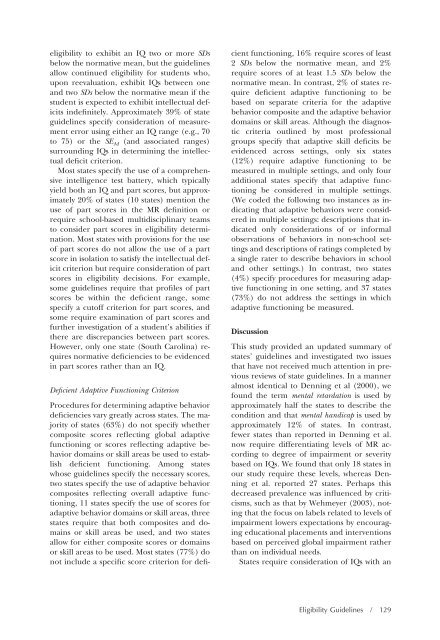Download the Journal (PDF) - Division on Autism and ...
Download the Journal (PDF) - Division on Autism and ...
Download the Journal (PDF) - Division on Autism and ...
Create successful ePaper yourself
Turn your PDF publications into a flip-book with our unique Google optimized e-Paper software.
eligibility to exhibit an IQ two or more SDs<br />
below <str<strong>on</strong>g>the</str<strong>on</strong>g> normative mean, but <str<strong>on</strong>g>the</str<strong>on</strong>g> guidelines<br />
allow c<strong>on</strong>tinued eligibility for students who,<br />
up<strong>on</strong> reevaluati<strong>on</strong>, exhibit IQs between <strong>on</strong>e<br />
<strong>and</strong> two SDs below <str<strong>on</strong>g>the</str<strong>on</strong>g> normative mean if <str<strong>on</strong>g>the</str<strong>on</strong>g><br />
student is expected to exhibit intellectual deficits<br />
indefinitely. Approximately 39% of state<br />
guidelines specify c<strong>on</strong>siderati<strong>on</strong> of measurement<br />
error using ei<str<strong>on</strong>g>the</str<strong>on</strong>g>r an IQ range (e.g., 70<br />
to 75) or <str<strong>on</strong>g>the</str<strong>on</strong>g> SE M (<strong>and</strong> associated ranges)<br />
surrounding IQs in determining <str<strong>on</strong>g>the</str<strong>on</strong>g> intellectual<br />
deficit criteri<strong>on</strong>.<br />
Most states specify <str<strong>on</strong>g>the</str<strong>on</strong>g> use of a comprehensive<br />
intelligence test battery, which typically<br />
yield both an IQ <strong>and</strong> part scores, but approximately<br />
20% of states (10 states) menti<strong>on</strong> <str<strong>on</strong>g>the</str<strong>on</strong>g><br />
use of part scores in <str<strong>on</strong>g>the</str<strong>on</strong>g> MR definiti<strong>on</strong> or<br />
require school-based multidisciplinary teams<br />
to c<strong>on</strong>sider part scores in eligibility determinati<strong>on</strong>.<br />
Most states with provisi<strong>on</strong>s for <str<strong>on</strong>g>the</str<strong>on</strong>g> use<br />
of part scores do not allow <str<strong>on</strong>g>the</str<strong>on</strong>g> use of a part<br />
score in isolati<strong>on</strong> to satisfy <str<strong>on</strong>g>the</str<strong>on</strong>g> intellectual deficit<br />
criteri<strong>on</strong> but require c<strong>on</strong>siderati<strong>on</strong> of part<br />
scores in eligibility decisi<strong>on</strong>s. For example,<br />
some guidelines require that profiles of part<br />
scores be within <str<strong>on</strong>g>the</str<strong>on</strong>g> deficient range, some<br />
specify a cutoff criteri<strong>on</strong> for part scores, <strong>and</strong><br />
some require examinati<strong>on</strong> of part scores <strong>and</strong><br />
fur<str<strong>on</strong>g>the</str<strong>on</strong>g>r investigati<strong>on</strong> of a student’s abilities if<br />
<str<strong>on</strong>g>the</str<strong>on</strong>g>re are discrepancies between part scores.<br />
However, <strong>on</strong>ly <strong>on</strong>e state (South Carolina) requires<br />
normative deficiencies to be evidenced<br />
in part scores ra<str<strong>on</strong>g>the</str<strong>on</strong>g>r than an IQ.<br />
Deficient Adaptive Functi<strong>on</strong>ing Criteri<strong>on</strong><br />
Procedures for determining adaptive behavior<br />
deficiencies vary greatly across states. The majority<br />
of states (63%) do not specify whe<str<strong>on</strong>g>the</str<strong>on</strong>g>r<br />
composite scores reflecting global adaptive<br />
functi<strong>on</strong>ing or scores reflecting adaptive behavior<br />
domains or skill areas be used to establish<br />
deficient functi<strong>on</strong>ing. Am<strong>on</strong>g states<br />
whose guidelines specify <str<strong>on</strong>g>the</str<strong>on</strong>g> necessary scores,<br />
two states specify <str<strong>on</strong>g>the</str<strong>on</strong>g> use of adaptive behavior<br />
composites reflecting overall adaptive functi<strong>on</strong>ing,<br />
11 states specify <str<strong>on</strong>g>the</str<strong>on</strong>g> use of scores for<br />
adaptive behavior domains or skill areas, three<br />
states require that both composites <strong>and</strong> domains<br />
or skill areas be used, <strong>and</strong> two states<br />
allow for ei<str<strong>on</strong>g>the</str<strong>on</strong>g>r composite scores or domains<br />
or skill areas to be used. Most states (77%) do<br />
not include a specific score criteri<strong>on</strong> for defi-<br />
cient functi<strong>on</strong>ing, 16% require scores of least<br />
2 SDs below <str<strong>on</strong>g>the</str<strong>on</strong>g> normative mean, <strong>and</strong> 2%<br />
require scores of at least 1.5 SDs below <str<strong>on</strong>g>the</str<strong>on</strong>g><br />
normative mean. In c<strong>on</strong>trast, 2% of states require<br />
deficient adaptive functi<strong>on</strong>ing to be<br />
based <strong>on</strong> separate criteria for <str<strong>on</strong>g>the</str<strong>on</strong>g> adaptive<br />
behavior composite <strong>and</strong> <str<strong>on</strong>g>the</str<strong>on</strong>g> adaptive behavior<br />
domains or skill areas. Although <str<strong>on</strong>g>the</str<strong>on</strong>g> diagnostic<br />
criteria outlined by most professi<strong>on</strong>al<br />
groups specify that adaptive skill deficits be<br />
evidenced across settings, <strong>on</strong>ly six states<br />
(12%) require adaptive functi<strong>on</strong>ing to be<br />
measured in multiple settings, <strong>and</strong> <strong>on</strong>ly four<br />
additi<strong>on</strong>al states specify that adaptive functi<strong>on</strong>ing<br />
be c<strong>on</strong>sidered in multiple settings.<br />
(We coded <str<strong>on</strong>g>the</str<strong>on</strong>g> following two instances as indicating<br />
that adaptive behaviors were c<strong>on</strong>sidered<br />
in multiple settings: descripti<strong>on</strong>s that indicated<br />
<strong>on</strong>ly c<strong>on</strong>siderati<strong>on</strong>s of or informal<br />
observati<strong>on</strong>s of behaviors in n<strong>on</strong>-school settings<br />
<strong>and</strong> descripti<strong>on</strong>s of ratings completed by<br />
a single rater to describe behaviors in school<br />
<strong>and</strong> o<str<strong>on</strong>g>the</str<strong>on</strong>g>r settings.) In c<strong>on</strong>trast, two states<br />
(4%) specify procedures for measuring adaptive<br />
functi<strong>on</strong>ing in <strong>on</strong>e setting, <strong>and</strong> 37 states<br />
(73%) do not address <str<strong>on</strong>g>the</str<strong>on</strong>g> settings in which<br />
adaptive functi<strong>on</strong>ing be measured.<br />
Discussi<strong>on</strong><br />
This study provided an updated summary of<br />
states’ guidelines <strong>and</strong> investigated two issues<br />
that have not received much attenti<strong>on</strong> in previous<br />
reviews of state guidelines. In a manner<br />
almost identical to Denning et al (2000), we<br />
found <str<strong>on</strong>g>the</str<strong>on</strong>g> term mental retardati<strong>on</strong> is used by<br />
approximately half <str<strong>on</strong>g>the</str<strong>on</strong>g> states to describe <str<strong>on</strong>g>the</str<strong>on</strong>g><br />
c<strong>on</strong>diti<strong>on</strong> <strong>and</strong> that mental h<strong>and</strong>icap is used by<br />
approximately 12% of states. In c<strong>on</strong>trast,<br />
fewer states than reported in Denning et al.<br />
now require differentiating levels of MR according<br />
to degree of impairment or severity<br />
based <strong>on</strong> IQs. We found that <strong>on</strong>ly 18 states in<br />
our study require <str<strong>on</strong>g>the</str<strong>on</strong>g>se levels, whereas Denning<br />
et al. reported 27 states. Perhaps this<br />
decreased prevalence was influenced by criticisms,<br />
such as that by Wehmeyer (2003), noting<br />
that <str<strong>on</strong>g>the</str<strong>on</strong>g> focus <strong>on</strong> labels related to levels of<br />
impairment lowers expectati<strong>on</strong>s by encouraging<br />
educati<strong>on</strong>al placements <strong>and</strong> interventi<strong>on</strong>s<br />
based <strong>on</strong> perceived global impairment ra<str<strong>on</strong>g>the</str<strong>on</strong>g>r<br />
than <strong>on</strong> individual needs.<br />
States require c<strong>on</strong>siderati<strong>on</strong> of IQs with an<br />
Eligibility Guidelines / 129
















